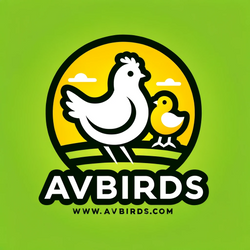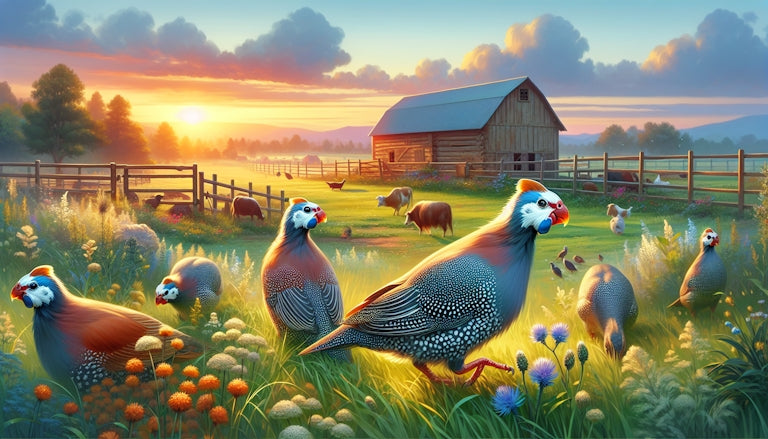If you’re searching for guinea keets for sale, you’ve landed in the right spot. Picture this: you’re ready to add a dash of chatter and garden security to your backyard flock. Guinea keets (baby guinea fowl) are curious, hardy, and excellent at pest control—insects, ticks, even snakes don’t stand a chance.
In this guide, you’ll learn how to find healthy guinea keets for sale, spot quality hatchery stock, pick the colors you love, and set up a brooder that helps your keets thrive. Ready to get started?
Why Choose Guinea Keets
Guinea keets are more than just cute chicks—they bring real value to your homestead.
- Pest Patrol: These little foragers munch on ticks, grasshoppers, and small snakes, keeping your veggie patch happy.
- Watchbirds: Their loud alert calls let you know when a fox or raccoon is snooping around.
- Egg Layers: Mature hens can lay about 100 brown, triangular eggs per year (March through August) (Freedom Ranger Hatchery).
- Lean Meat: French Guinea fowl reach 4 lbs by 12 weeks when fed properly, offering tender, dark meat for your table.
Here’s the thing—you’ll save time and energy on pest control while enjoying fresh eggs and tasty meat. Sounds like a win-win.
Where To Find Guinea Keets For Sale
You’ve got options, from big hatcheries to small-scale breeders. Let’s break them down.
Hatchery Direct Options
- Cackle Hatchery: Sells only unsexed keets. Thousands hatch weekly May–August, orders accepted from November (Cackle Hatchery).
- Freedom Ranger Hatchery: Known for fast-growing French Guinea keets, ideal if you’re chasing meat-bird performance.
Specialty Breeders
Local or regional breeders often stock fancy assortments—think Coral Blue or Royal Purple. You may pay a bit more, but they usually guarantee rare colors and healthy chicks.
Seasonal Timing
Keets ship best in spring and early summer when brooding conditions are easy to manage. If you order too early, prepare heat lamps; too late, and you risk muggy weather stressing young birds.
Spotting Healthy Keets
Once keets arrive at your doorstep, you’ll want to give them a quick health check—no fuss, just scan and go.
Physical Checks
- Bright Eyes & Clean Nostrils: Cloudy eyes or crusty nares (nostrils) can signal illness.
- Smooth, Fluffy Down: Patchy or dirty down may mean they’ve been chilled or overcrowded.
- Active Posture: Healthy keets stand tall and eager, not huddled in a corner.
Behavior Signs
- Alert Chirps: Keets should chirp when they see you—silence might mean stress or sickness.
- Steady Breathing: Wheezy or rapid breaths are red flags.
If more than 10 percent seem off, contact your supplier immediately. Most reputable hatcheries offer replacements or credits for shipment losses.
Exploring Color Varieties
Guinea keets come in a rainbow of hues, from the classic to the downright exotic. Here’s a quick look at popular options:
| Color Variation | Description | Starting Price | Source |
|---|---|---|---|
| Pearl Gray | Silvery body with dark spots | $4.95 | Guinea Farm (link) |
| White African | Pure white with pinkish legs | $5.35 (4 + colors) | Guinea Farm |
| Coral Blue | Soft blue-gray plumage | $5.35 | Guinea Farm |
| Lavender | Pale lavender tint on gray down | $6.50 (small pack) | Guinea Farm |
| Royal Purple | Deep purple sheen on head and wings | $6.50 | Guinea Farm |
| Buff Dundotte | Warm buff base with brown speckles | $4.95 | Guinea Farm |
| Greater Pearl (Penguin) | Black belly, white wings | $6.75 | Guinea Farm |
Looking for more? Rare assortments can include Ivory, Powder Blue, Sky Blue, even Jumbo keets—all at specialty breeder prices.
Setting Up Your Brooder
A cozy brooder is the foundation for healthy guinea keets. Here’s how to nail it from day one.
Temperature & Equipment
- Start at 95 °F under a heat lamp, then drop 5 °F every three days until they roost on their own (Azure Farm Life).
- Provide clean, dry bedding—pine shavings work best.
- Offer easy-access waterers and feeders. Check out chick brooder supplies and chicken feeders and waterers for trusted gear.
- If you’re hatching your own eggs, don’t forget incubators and hatching accessories.
Feeding Routines
- Weeks 0–4: 28 percent game-bird/turkey starter.
- Weeks 5–8: 18 percent grower ration.
- Week 9 onwards: 16 percent layer mash.
Clean, lukewarm water (with optional electrolytes) encourages consistent growth and keeps keets from overeating pellets.
Raising Your Flock
Once your keets hit about four weeks, it’s time to think bigger—literally.
Space & Housing
- Minimum Flock Size: At least three guineas to prevent stress—six to eight is ideal in a coop run.
- Acreage Guideline: Up to 30 birds per acre if free-ranged, otherwise give each bird 3–4 sq ft of coop space.
- Predator Proofing: Secure fencing 18 inches buried to deter diggers, plus a sturdy hardware cloth wrap.
Health & Integration
Guinea fowl are social but cautious. Introduce them to older poultry slowly, ideally through a barrier that lets them see and hear each other before full integration.
Keep an eye out for mites or lice, and trim beaks only if they grow past the bottom of waterers. Routine health checks and clean housing help prevent common issues.
Key Takeaways
- Start your search early—orders open in November, with peak hatch May–August.
- Check keet health on arrival: bright eyes, fluffy down, lively chirps.
- Explore a spectrum of colors from Pearl Gray to Royal Purple, with prices around $4.95–$7.50.
- Build a brooder at 95 °F, then taper heat, and follow a staged feeding plan.
- Give your flock space, companionship, and careful introductions to other birds.
Ready to add guinea keets to your backyard ecosystem? Grab your heat lamp, order your chicks, and share your new flock story in the comments below.

